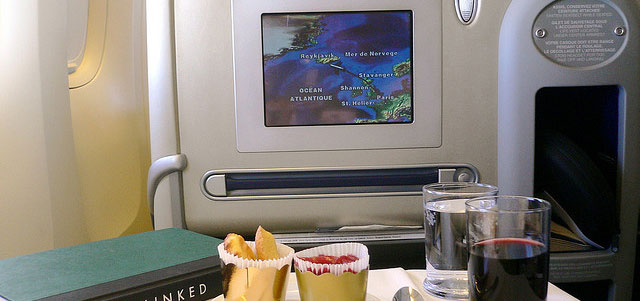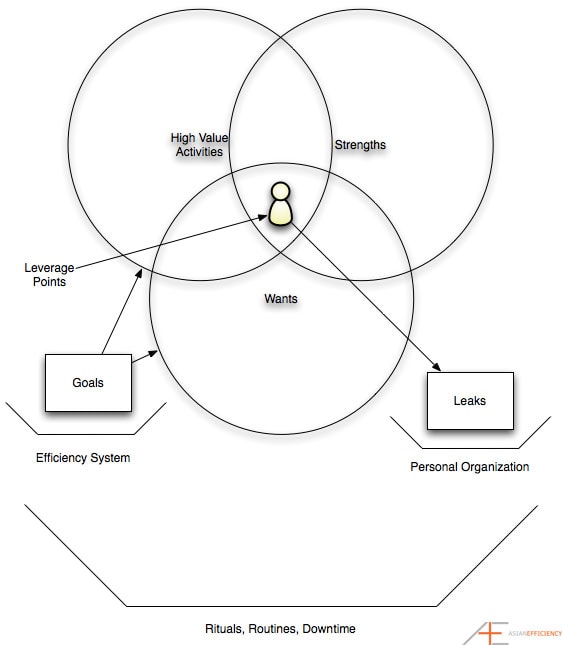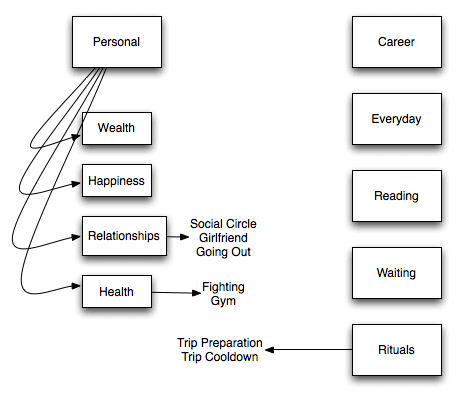
One of the things that we discussed in the last case study we published was that everyone has different needs and wants in terms of efficiency, and therefore they need different solutions to implement. Today I’d like to introduce you to Steve – who lives a very interesting, very busy and very public life. (note: names and some details have been changed).
Meet Steve
Steve is an American in his 30s. He has a job that requires him to travel most of the time, going from city to city across the United States. His job is also fairly intense, requiring him to continually study (learn) different aspects of his industry, in addition to working and maintaining the rest of his life. When we first talked to Steve, his biggest issue was not knowing what he should be focussing on – his career, his studies, or just simply becoming more consistent.
Here’s what he wanted:
- To focus more time on his career.
- To take up meditation.
- To add some sort of physical practice to his life – like fighting (martial arts).
- To become more consistent in his habits and schedule, and work around the haphazard nature of his work.
We identified some time-wasters and inefficient habits:
- Spending a lot of time texting.
- Spending a lot of time on non-work-related Facebook and email (note: this is not to say that you should spend a lot of time on work-related facebook or email).
- Battling between emotion and logic, and acting from feelings rather than from necessity.
- Not batching activities that could be.
- Spending too much time eating.
- Multitasking.
- Doing things last minute.
- Not knowing what to do next.
Steve didn’t have much in terms of an efficiency system, but he did point out that the travel details for his work were of crucial importance to him.
He also pointed out that he was very good at writing detailed roadmaps for what to do – the only problem being that he only followed them some of the time.
Framework
You may remember this awesome diagram that we drew for Daniel:

The same framework applies to Steve.
Leverage Points
As before:
Leverage points are the intersection of high value activities, natural strengths, and wants. They are the things that you do that push you towards your goals, yet also make you happy while doing so. There are two components to leverage: the first is making sure you are doing things where you have optimal leverage, the second is the removal of leaks that would otherwise cause a loss of momentum and progress.
In Steve’s case, the leverage points arise out of necessity – not happiness. They arise from having things to do that are actionable (and necessary), and that have sufficient reason behind them. They are:
- Learning how to keep things going while traveling.
- Having a 1-day “reset routine” from when back from a trip.
- Contextual separation.
- Handling procrastination.
All these leverage points are geared towards addressing inefficient habits, and creating consistency. The rest of Steve’s wants (career time, meditation, fighting) can be achieved through clever scheduling.
We already have a fairly extensive article about working productively while traveling but here are some additional things we told Steve:
- Factor in travel time. To and from the airport and in waiting for a flight.
- Learn to say no. Steve spends a lot of time in different cities, and the temptation is to go out all the time and sightsee and generally have a good time. He has to recognize that being in a different city is simply part of his lifestyle and his everyday life, and that it should not prevent him from doing the things he knows he should be – like putting time towards career study. Put simply, when in a different city, he should act as-if he were at home.
- Have a 1-day reset routine to recover from trips. Steve actually knew what he already needed to do in terms of getting himself recovered from a trip – he just needed to implement it!
Steve is something of a perfectionist, so we introduced him to the concept of contextual separation. What this means, is that while at work, Steve can be as much of a perfectionist as he likes (or needs) to be. While at home however, he needs to realize that it is really not necessary. Again, he needed to learn to say no to certain things, to recognize when something is not worth his time (and outsource it), and that “good enough is good enough”. Most importantly, he needed to realize that there is a huge opportunity cost in time when you try to be perfect at everything.
That’s worth repeating:
There is a huge opportunity cost in time when you try to be perfect at everything.
Handling Leaks
From above, Steve had a number of bad habits that needed to be addressed:
- Spending a lot of time texting.
- Spending a lot of time on non-work-related facebook and email.
- Battling between emotion and logic, and acting from feelings rather than from necessity.
- Not batching activities that could be.
- Spending too much time eating.
- Multitasking.
- Doing things last minute.
- Procrastination.
- Not knowing what to do next.
Let’s look at these one by one.
- For texting and facebook and email, we advised Steve to follow out standard email guidelines. The simple version, is to check facebook and email once in the morning, and once in the evening, and not in-between. We pointed out that text messaging is asynchronous communication – that there is an expectation of delay between receipt of message and reply. It is entirely up to you when you choose to reply.
- To handle emotions and logic, we suggested that Steve follow the advice our friend Jim S gave us – catch the emotion. Doing things based on feelings can be a good strategy if you are a solo entrepreneur starting out, or a university student. In Steve’s case, his work is too important and his scheduling too tight too allow for this – he needed to introduce a certain amount of self-discipline. We told him to ask a simple question when he recognized that a certain non-useful emotion arose: “What is the non-emotional decision in this instance?” and then to proceed with that answer.
- Batching is the concept of grouping together semantically or contextually-related activities. For example, a trip to the grocery store can be bundled with stops at the bank and post office and perhaps the gym on the way back (contextual grouping). Or, household chores such as dishes can be left together in a dishwasher for a single cleaning cycle (semantic grouping).
- Steve’s main issue with multitasking is that he would study printed manuals and texts in front of the computer while in facebook and instant messaging. Simple solution: don’t study in front of the computer.
- To address the issue of not knowing what to do next, we gave Steve a simple question to ask himself: “What can I work on now that will give me the most benefit across every area of this?” So say for example, he could ask “What can I work on right now that will give me the most benefit across every aspect of my career?” That is exactly what Steve should be working on next.
- With food, here at AE we actually believe in taking the time to get proper nutrition, as it is the foundation for physical energy and thus productivity – take as much as you need to eat within reason – 30-45 minutes per meal should be plenty.
We’ll address procrastination and doing things last-minute in the section on Steve’s Efficiency System below.
Rituals, Routines and Downtime
As with Daniel, the foundation for everything that Steve does should his be rituals, routines and downtime. This is because of the huge impact that our physical energy has on our ability to be productive in everything else.
For Steve, downtime primarily consisted of a number of “crazy rampage” periods that allowed him to cut loose and renew himself. We agreed on the renew part – and less so on the rampage part. Towards that end, we gave him a couple of rituals (morning and evening) and a set of new guidelines to work downtime into his busy schedule.
Steve’s Morning Ritual
- Wake up.
- Drink 500mL of water.
- Use bathroom.
- Review goals for day. Review from journal what is to be accomplished and note down in journal.
- Meditation.
- Check email, facebook and phone. Reply, clear and sort as necessary. Synchronize Things to iPhone.
- Eat breakfast.
- Gym (can defer to later in the day).
- Start of the day – most important task first. This pushes the boundaries of your life and creates a snowball effect.
Steve’s Evening Ritual
- Career study.
- Write a journal entry outlining your day. Review tasks completed during the day, and see how it compares to the morning entry. Set tasks and review goals for tomorrow.
- 30 minutes of visualization exercises.
- Sleep.
Downtime
We rather like the idea of “cutting loose” as downtime – we just don’t think that it necessarily has to be self-destructive to be effective. Steve told us that after one of his “benders” it would often take 2-3 days to recover. We felt that that was too much time, and suggested that he schedule in MORE downtime MORE often, and place boundaries around partying:
- Pick two evenings to spend with significant other(s). Extend this to three if two is not enough.
- Take one day off per week to just enjoy.
- Every couple of months, take a week off for vacation time – significant other(s) optional.
- Pick one weekend every month as “party time” – drink water and alcohol in equal amounts during that time.
Efficiency System
Steve had no personal organization system to speak of – beyond a bunch of random notes collected on his iPhone. We gave him the basics of a system:
1. Switch to Mac
- Find a Apple Store Genius that will help you migrate from Windows to Mac.
- Get a 500GB hard disk as a Time Machine backup.
- Obtain a MobileMe subscription to keep PIM information in synchronization.
2. Scheduling
- Use iCal on the Mac, Calendar on the iPhone. (note: nowadays we recommend BusyCal for Mac and WeekCal for iPhone).
- Use TripIt to manage flight and travel information. If necessary, pay a VA to input the information manually. Use the TripIt application on the iPhone and create a subscription calendar on the Mac/iPhone so that flights and travel data are directly in-schedule.
3. Contacts
- Address Book on Mac, Contacts in iPhone.
4. Task Management
- Use Things for Mac, and sync to iPhone. (note: this is because Steve had relatively fewer business tasks to track).
- Once all tasks are in Things, then finding the next action and doing things last-minute becomes an after thought. You will be able to see very clearly what is due and when, and plan accordingly for it.
- When clearing tasks, use the Pomodoro Technique.
- Steve’s task management breakdown:

5. Information and Notes
- Notes on iPhone. VoodooPad as personal wiki on the Mac.
6. Journal
- Utilize MacJournal to write and record daily journal entries.
- Ask four questions every day:
1. What have I appreciated and enjoyed the most in the past day?
2. What have I done really exquisitely?
3. How have I improved?
4. Based on today, how can I do things better tomorrow?
Goal setting
We did in fact give Steve a systematic goal setting (and more importantly, goal achieving) process, but we will cover this in detail in an upcoming article. You can also check out AE Thanh’s quick guidelines for setting goals here.
In Closing
As you’ve seen, the challenges that Steve faced were quite different from those that Daniel did. Again, the solutions lay in the foundations of what we share here at Asian Efficiency – just optimized to better suit each individual’s situation.
Photo by: jurvetson
